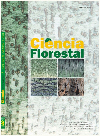
|
Ciência Florestal
Centro de Pesquisas Florestais - CEPEF, Departamento de Ciências Florestais - DCFL, Programa de Pós Graduação em Engenharia Florestal - PPGEF
ISSN: 0103-9954
EISSN: 0103-9954
Vol. 24, No. 3, 2014, pp. 727-740
|
 Bioline Code: cf14070
Bioline Code: cf14070
Full paper language: Portuguese
Document type: Note
Document available free of charge
|
|
|
Ciência Florestal, Vol. 24, No. 3, 2014, pp. 727-740
| pt |
ESPÉCIES FLORESTAIS DE RESTINGAS COMO POTENCIAIS INSTRUMENTOS PARA GESTÃO COSTEIRA E TECNOLOGIA SOCIAL EM CARAVELAS, BAHIA (BRASIL)
Dias, Henrique Machado; Soares, Mario Luiz Gomes & Neffa, Elza
Resumo
Em Caravelas, município localizado no sul do estado da Bahia, as principais formações vegetais são as
florestas de mangue e as restingas apresentando, estas últimas, alto grau de degradação. O objetivo deste
artigo consiste em descrever as principais espécies florestais de restingas e seus usos diretos associados,
com vistas à recuperação e ao manejo de áreas degradadas e à geração de trabalho e renda, compondo, dessa
forma, importante ferramenta para a gestão integrada da zona costeira. Para isso, a elaboração de listagens
florísticas e visitas ao campo foram necessárias para reconhecimento do ambiente. Na seleção das espécies,
uma literatura referente ao uso, manejo e valor agregado de cada uma das espécies identificadas foi utilizada
e, a partir daí, foram reconhecidas quatro espécies com potencialidade para geração de trabalho e renda
nos moldes dessa proposta: mangaba ( Hancornia speciosa

), pitanga ( Eugenia uniflora

), caju ( Anacardium
occidentale

) e aroeira ( Schinus terebinthifolius

). As três primeiras apresentam associação de seus frutos
ao uso alimentar, servindo a aroeira como condimentação, com alta valorização no mercado mundial, e o
caju, a partir da sua estrutura fértil (castanha e polpa). A identificação dos subprodutos vegetais fornecidos
assegura a utilização sustentada das espécies e do ambiente e os Produtos Florestais Não Madeiráveis
podem ser estratégicos no gerenciamento costeiro, tornando-se instrumento para se alcançar inclusão social
através da geração de trabalho e renda, sob o movimento da Tecnologia Social, contribuindo, portanto, para
a redução da vulnerabilidade social de comunidades costeiras tradicionais.
vulnerabilidade; desenvolvimento local; produtos florestais não madeiráveis; inclusão social
|
| |
| en |
FOREST SPECIES OF COASTAL PLAIN AS POTENTIAL TOOLS FOR COASTAL MANAGEMENT AND SOCIAL TECHNOLOGY IN CARAVELAS, BAHIA (BRAZIL)
Dias, Henrique Machado; Soares, Mario Luiz Gomes & Neffa, Elza
Abstract
In Caravelas, located in southern Bahia state, the main vegetation formations are the mangrove forests
and ‘restingas’ (sandbanks) presenting, the latter, a high degree of degradation. The aim of this paper is
to describe the main forest species of these ‘restingas’ and their direct uses associated with the recovery
and management of degraded areas and creation of jobs and income, making thus an important tool for
integrated coastal zone. For this, elaborate floral listings and field visits were necessary for recognizing
the environment. In the selection of species, a literature about the use, management and value of each
species were used, and from there, four species with potential for generating jobs and income along of
this proposal were recognized: Mangaba ( Hancornia speciosa

), Pitanga ( Eugenia uniflora

), Mangaba
( Anacardium
occidentale

) and Aroeira ( Schinus terebinthifolius

). The first three are associated with the use of its fruit food, serving these ‘aroeiras’ as pepper trees, with a high value on the world market, and
cashew, because of its fertile structure. The identification of products provided sustainable use of species
and environment and the Non-Timber Forest Products can be strategic in coastal management, making it
an instrument to subsidize social inclusion through the creation of jobs and income, under the movement of
Social Technology, contributing to reduce the social vulnerability of traditional coastal communities.
vulnerability; local development; non-timber forest products; social inclusion
|
| |
© Copyright 2014 - Ciência Florestal
Alternative site location: http://cascavel.ufsm.br/revistas/ojs-2.2.2/index.php/cienciaflorestal/index
|
|
